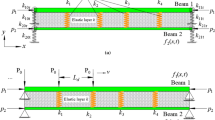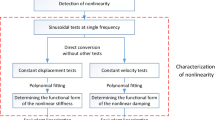Abstract
It is well-known that the responses of a structure are different when subjected to a static load or a sudden step load. The dynamic amplification factor (DAF), which is defined as the ratio of the amplitude of the vibratory response to the static response, is normally used to depict the dynamic effect. For a single-degree-of-freedom system (SDOF) subjected to a sudden dynamic load, the maximum value of DAF is 2. Many design guidelines therefore use 2 as an upper bound to consider the dynamic effect. For a civil engineering structure, which is normally a multiple-degrees-of-freedom (MDOF) system, the DAF may exceed 2 in certain circumstances. The adoption of 2 as the upper bond as suggested by the design guidelines therefore may lead to unsafe structural design. Very limited studies systematically investigate the DAF of a MDOF system. This study theoretically investigates the DAF of a MDOF system when it is subjected to a step load based on the fundamental theory of structural dynamics. The condition on which the DAF may exceed 2 is defined. Two numerical examples and one experimental study of a cable-stayed bridge subjected to sudden cable loss are presented to illustrate the problem.
Similar content being viewed by others
References
Aoki Y, Valipour H, Samali B and Saleh A (2013), “A Study on Potential Progressive Collapse Responses of Cable-Stayed Bridges,” Advances in Structural Engineering, 16(4): 690–706.
Cai J, Xu Y, Zhuang L, Feng J and Zhang J (2012), “Comparison of Various Procedures for Progressive Collapse Analysis of Cable-Stayed Bridges,” Journal of Zhejiang University-SCIENCE A (Applied Physics & Engineering), 13(5): 323–334.
Cai J and Feng J (2015), “Form-Finding of Tensegrity Structures Using an Optimization Method,” Engineering Structures, 104: 126–132.
Cai J, Jia W, Feng J, Wang F and Xu Y (2017), “Applications of Stiffness-Based Evaluation Method to Element Importance of Truss Systems,” Journal of Civil Engineering and Management, 23(5): 562–572.
Chen Y and Feng J (2010), “Elastic Stability of Shallow Pin-Ended Parabolic Arches Subjected to Step Loads,” Journal of Central South University, 17(1): 156–162.
Chen Y, Sareh P and Feng J (2015), “Effective Insights into the Geometric Stability of Symmetric Skeletal Structures under Symmetric Variations,” International Journal of Solids and Structures, 69-70: 277–290.
Chopra AK (2012), Dynamics of Structures: Theory and Applications to Earthquake Engineering (4th), New York: Prentice Hall.
Clough RW and Penzien J (1993), Dynamics of Structures, New York: McGraw-Hill Inc.
European Committee for Standardization (2006), “Eurocode 1: Actions on Structures, Part 1.7: Accidental Actions,” EN 1991-1-7:2006, Brussels, Belgium.
Gerasimidis S and Baniotopoulos CC (2011), “Disproportionate Collapse Analysis of Cable-Stayed Steel Roofs for Cable Loss,” International Journal of Steel Structures, 11 (1): 91–98.
Hamidreza Tavakoli, Saman Soleimani Kutanaei and Seyed Hossein Hosseini (2019), “Assessment of seismic amplifi cation factor of excavation with support system,” Earthquake Engineering and Engineering Vibration, 18(3): 555–566. https://doi.org/10.1007/s11803-019-0521-x.
Mozos CM and Aparicio AC (2009), “Static Strain Energy and Dynamic Amplification Factor on Multiple Degree of Freedom Systems,” Engineering Structures, 31(11): 2756–2765.
Mozos CM and Aparicio AC (2010), “Parametric Study on the Dynamic Response of Cable Stayed Bridges to the Sudden Failure of a Stay, Part I: Bending Moment Acting on the Deck,” Engineering Structures, 32(10): 3288–3300.
Liu R, Li X, Xue S, Mollaert M and Ye J (2017), “Numerical and Experimental Research on Annular Crossed Cable-Truss Structure Under Cable Rupture,” Earthquake Engineering and Engineering Vibration, 16(3): 557–569.
Post-Tensioning Institute (2007), “Recommendations for Stay Cable Design, Testing and Installation (5th),” In: Cable-Stayed Bridges Committee (ed), P.T.I. DC45.1-12, Phoenix, USA.
Ruiz-Teran AM and Aparicio AC (2007), “Dynamic Amplification Factors in Cable-Stayed Structures,” Journal of Sound and Vibration, 300(1): 197–216.
Ruiz-Teran AM and Aparicio AC (2009), “Response of Under-Deck Cable-Stayed Bridges to the Accidental Breakage of Stay Cables,” Engineering Structures, 31(7): 1425–1434.
Sun L, Luo F and Chen T (2005), “Transient Response of a Beam on Viscoelastic Foundation Under an Impact Load During Nondestructive Testing,” Earthquake Engineering and Engineering Vibration, 4(2): 325–333.
Wani A and Talikoti RS (2016), “A Study on Progressive Collapse Response of Cable-Stayed Bridges for Deflection and Axial Force in Cables,” international Research Journal of Engineering and Technology, 3(5): 1840–1843.
Wolff M and Starossek U (2009), “Cable Loss and Progressive Collapse in Cable-Stayed Bridges,” Bridge Structures, 5(1): 17–26.
Zhou Y and Chen S (2015), “Numerical Investigation of Cable Breakage Events on Long-Span Cable-Stayed Bridges under Stochastic Traffic and Wind,” Engineering Structures, 105(07): 299–315.
Zhou Y and Chen S (2016), “Framework of Nonlinear Dynamic Simulation of Long-Span Cable-Stayed Bridge and Traffic System Subjected to Cable-Loss Incidents,” Journal of Structural Engineering, 142(3): 1–17.
Acknowledgement
This paper was prepared during the author’s stay at the Centre for Infrastructural Monitoring and Protection (CIMP) at Curtin University. This work was supported by the National Science Foundation of China (NSFC) (51508102), China Postdoctoral Science Foundation (2018M631292), and the Beijing Postdoctoral Science Foundation (2018-ZZ-032). Financial support was also provided by the China Scholarship Council (CSC) (201406655012).
Author information
Authors and Affiliations
Corresponding author
Additional information
Supported by: National Science Foundation of China (NSFC) under Grant No. 51508102, China Postdoctoral Science Foundation under Grant No. 2018M631292, and the Beijing Postdoctoral Science Foundation under GrantNo. 2018-ZZ-032. Financial support was also provided by the China Scholarship Council (CSC) under Grant No. 201406655012
Rights and permissions
About this article
Cite this article
Chao, Z., Hong, H., Kaiming, B. et al. Dynamic amplification factors for a system with multiple-degrees-of-freedom. Earthq. Eng. Eng. Vib. 19, 363–375 (2020). https://doi.org/10.1007/s11803-020-0567-9
Received:
Accepted:
Published:
Issue Date:
DOI: https://doi.org/10.1007/s11803-020-0567-9




